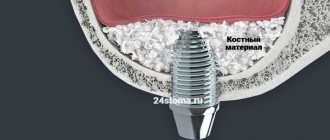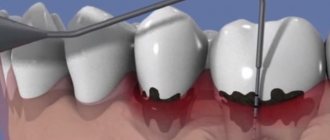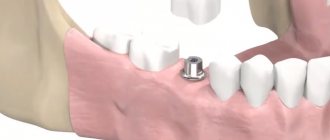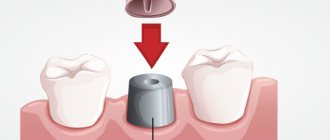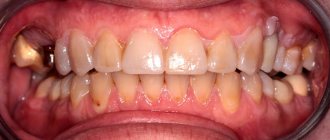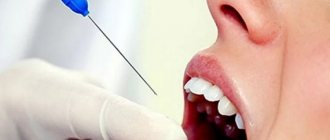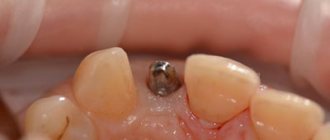What is a sinus lift?
Sinus lifting (sinus floor elevation) is a procedure for increasing bone tissue in the area of the maxillary sinuses. They are located on the upper jaw to the left and right of the nose. In most people, the roots of the chewing teeth of the upper jaw are initially located in the maxillary sinuses, so after the removal of these teeth there is not enough bone tissue to install an implant. Closest to the maxillary sinuses are the molars (sixth and seventh teeth), less often the premolars (fourth and fifth teeth), and sometimes the canines.
The orthopantomogram shows the boundaries of the bottom of the maxillary sinuses and the apex of the alveolar ridge. There is not enough bone tissue to install implants.
Sometimes native bone is not enough
The bone of the upper jaw is more porous and, in the presence of a tooth, is penetrated by a system of capillaries that nourish the bone. If a patient removes a tooth and does not think about installing an implant immediately, then after 6 months thinning of the bone tissue is observed.
This occurs due to the absence of a tooth, which was responsible for the functioning of the bone. The absence of a tooth root leads to a lack of chewing load, the “feeding” of blood stops and the spongy substance becomes thinner. After a year, subsidence reaches its peak and when installing an implant or bridge, a sinus lift of the jaw will absolutely be required.
At the same time, in elderly patients, thinning occurs even from the side of the maxillary sinus - from the inside.
You can avoid the consequences by installing an artificial dental implant in place of the extracted tooth within a period that will not exceed six months after surgery.
Types of surgery
Indications for a sinus lift are a lack of bone tissue, and even if one millimeter is not enough to securely install a new six, for example, the matter cannot be done without surgical intervention.
Additional Information. According to available statistics, 80% of patients suffer from a lack of maxillary ridge height. The risk group includes people who lost their teeth more than six months ago, suffering from periodontal disease and cysts. In addition, thinning bone tissue is sometimes a congenital feature.
The type of manipulation depends on the size of the missing tissue.
Closed operation
A closed sinus lift is a simpler type of surgery that is easier for the patient to tolerate. Includes several steps:
- Creation of several holes in the gum that are drilled into the bone. It is important at this stage to act carefully and not damage the sinus membrane, so specialists use data from computed tomography or 3D images;
- Insertion of instruments through the resulting holes and displacement of the bottom of the sinus;
- Filling the cavity with bone tissue;
- Installation of implants immediately after thickening the bone - they are installed inside the sinus, simulating the roots of the teeth, and plugs are screwed onto them from the outside;
- Suturing of the gums takes up to 10 days, the period depends on the size of the operation area.
The use of this method is possible only if the thickness of the “native” bone is sufficient, from 5 mm. In this case, it is possible to install three root implants at once.
The formation of a pocket for filling is carried out either using a balloon ball, which, when inflated, creates the required volume (the safest method), or with hand tools using a mechanical method.
Open surgery
Open sinus lifting is a complex, full-fledged surgical intervention, which is performed when there is significant thinning of the tissue (more than 6 mm) and in the absence of three or more teeth in the dentition.
Procedure of manipulations:
- Detachment of gingival matter. The doctor carefully pries and lifts the thin gum to get to the bone;
- Osteotomy - drilling out a small section of bone to open access to the maxillary sinus;
- Lifting the sinus membrane from the inside and filling the formed pocket with bone tissue.
Creating a space in the bone can lead to perforation of the meningeal sinus. In this case, the doctor either sews up the holes and continues working, or applies stitches and postpones further actions until after healing.
Next, the dental surgeon decides to immediately place an implant if there is a slight lack of bone, or:
- add bone material;
- apply a membrane;
- cover the bone with gum;
- apply stitches.
After the new materials have implanted, the patient returns after 3-4 months to have implants installed.
Contraindications
Any surgical intervention has contraindications and sinus lift surgery is no exception.
Absolutely prohibited:
- clotting problems and other disorders of the heart and circulatory system (including heart failure);
- various diseases of the immune system, including AIDS and HIV (can lead to implant rejection);
- hormonal diseases (thyroid problems and diabetes);
- recent chemotherapy or radiation therapy;
- oncological diseases in the active phase of treatment;
- any bad habits such as alcoholism, smoking, etc.
There are also relative contraindications that can be addressed before lifting surgery:
- acute viral infections;
- ENT diseases in the acute phase;
- caries and stomatitis.
Important! Hold off on manipulations for colds, especially those accompanied by a runny nose. First - health, then - implants.
Thus, before going to the surgeon, it is necessary to sanitize not only the oral cavity, but also the entire body.
If lifting is still contraindicated for the patient, then shorter implants and a conditionally removable prosthesis can be installed.
Materials used
Material for bone tissue augmentation can be:
- Autograft is the patient’s native bone, which is obtained by cutting from the lower jaw or chin. Afterwards, the material is crushed and the pocket formed by raising the sinus is closed. This material prevents rejection by the immune system, engraftment is ideal, however, the downside is the high risk of injury - you need to wait for two surgical sites to heal, especially if a lot of material is required for filling.
Attention! Internal components thin out faster and in this case additional augmentation will be required.
2. Materials of animal origin, which are obtained from samples of bones of cattle. In this case, after grinding, the substance undergoes mandatory sterilization and removal of impurities (collagen) for drying. The resulting crumbs can be adjusted to the required size by pressing into blocks. This material has a good survival rate and low cost, so it is most common among surgeons. The animal components begin to interact with the tissues that surround them, forming new bone and being resorbed when the job is done.
On a note! Often, animal tissue is mixed with autograft to reduce the cost of surgery.
3. Artificial fabric - consists of synthetic fibers - granulate or calcium phosphate. The composition contains a replacement for the building bone substance - hydroxyapatite. The action is similar to the animal component; after bone growth, resorption occurs. Modern materials are high cost, but stimulate an active regeneration process, as well as biocompatibility.
The choice of material depends on several factors:
- the amount of bone tissue to be inserted into the sinus;
- the capabilities of the patient's lower jaw;
- funds available to a person.
What happens after
Complications after a sinus lift are possible, since this manipulation is considered a full-fledged surgical intervention. The only question is how to avoid most of them and prepare for treatment.
Medical errors
They can be avoided if you choose a trusted clinic. Choose carefully who you trust with your jaw to avoid:
- Incorrect choice of augmentation method (this can happen due to illiterate diagnosis and determination of bone tissue thickness), resulting in rapid rejection or destruction of the implant;
- Violation of operation technology and sanitary standards.
The dentist’s inexperience may also manifest itself during the manipulation process:
- perforation of the sinus wall - this requires urgent suturing of the film or application of collagen material, you need to act quickly and accurately;
- in turn, undetected perforation leads to the entry of bone tissue into the maxillary sinuses, which in the future will manifest itself as constant congestion, sinusitis and other complications;
- bleeding is a common situation, but can unsettle you;
- infection in case of non-compliance with epidemiological rules, which leads to tissue suppuration, chronic infectious diseases of the respiratory tract and the formation of cysts.
Reviews from patients and friends will help you avoid “medical” complications after a sinus lift. Approach this with full responsibility.
Patient unconsciousness
Choosing a good clinic is not enough. It is important to follow all the recommendations given by the specialist after the operation, and also not to withhold information at the stage of collecting anamnesis and diagnosis. Violation of these principles will lead to:
- inflammation of the sinuses;
- uncontrolled bleeding during and after manipulations;
- suture infection and bone inflammation;
- rejection or slight mobility of implants;
- pushing artificial materials deep into the jaw (in case of violation of nutritional rules);
- loss of transplanted tissue due to severe sneezing and coughing;
- ENT complications.
Recommendations
The list of tips for maintaining the desired effect is quite extensive, here are the main points:
- take prescribed medications on time, especially antibiotics and anti-allergy drugs;
- follow a certain diet - only soft and warm food in the first weeks before the sutures are removed, chew on the healthy side to avoid unnecessary stress;
- Avoid physical activity until the sutures are removed, then only light exercise for up to a month;
- If possible, avoid air travel;
- to avoid swelling after sinus lifting, it is necessary to avoid visiting the pool and saunas;
- do not create unnecessary tension in the nasal cavity - try to sneeze, cough and blow your nose less.
Inconvenience can be avoided if an implant is placed in time to replace the extracted tooth. But, if there are indications and time has passed, select a reliable specialist and then everything will go well.
Indications
To install an implant, a minimum of 10 mm of bone tissue is required to the maxillary sinus. Otherwise, a rise in its bottom is shown.
1) If the distance to the sinus is 8-10 mm, it is possible to perform a closed sinus lift with simultaneous installation of implants. The term “closed” means that no additional incisions are required. This can be compared to endoscopic operations. The postoperative period is easier.
2) If there is bone tissue from 5 mm to 8 mm, an open sinus lift (classic version) is performed with simultaneous installation of implants. This technique creates access to the maxillary sinus from the cheek. Its mucous membrane is peeled off, lifted, and bone-substituting material is placed in the resulting space, which is absorbed and replaced with its own bone.
3) If the distance to the maxillary sinus is less than 5 mm, an open sinus lift is performed without installing implants. For immediate installation of implants, a sufficient volume of bone tissue is required in which they will be stabilized. If it is not enough, then the bone volume is first increased. After 6-9 months, implants are installed. After another 6 months, crowns are installed on the implants. With severe atrophy of bone tissue in the upper jaw, the treatment period can be more than a year.
Possible complications
Sinus lifting of the upper jaw is safe if it is performed by a specialized dentist in a clinic with the necessary equipment. However, in some cases, negative consequences may occur both during the operation itself and during the rehabilitation period:
- perforation of the maxillary sinus;
- pushing the implant into the sinus;
- development of acute sinusitis, which, if left untreated, can become chronic;
- poor fastening, mobility of the structure;
- wound infection;
- bleeding from the nose or wound;
- implant rejection.
Immediately after the procedure, swelling, pain, and redness of the mucous membranes occur. Body temperature may increase. These phenomena go away on their own after a few days. To alleviate the condition, you can take analgesics, antipyretics, and rinse your mouth with antiseptics.
If infection or damage to soft tissue occurs, complications become apparent within the first 3 days. If the temperature rises, pain or swelling increases, you should consult a doctor.
Contraindications
In addition to general contraindications (type 1 diabetes, recent radiation therapy, etc.), there are a number of factors that may carry additional risks for the operation. The most common limitation is inflammatory diseases in the maxillary sinus area. It is necessary to identify the source of inflammation. Additional consultation with an ENT specialist may be required. Some difficulties may be due to previous operations in the area of the maxillary sinuses.
Diagnosis before surgery
To properly plan the procedure and select the optimal one, it is necessary to undergo diagnostics. An important step is to refer the patient for a computed tomography (CT) scan - this way the doctor will have a complete picture of the structure of the upper jaw and maxillary sinus, as well as the exact measurements of the thickness of the bone and sinus membrane. Additionally, blood tests are required, at a minimum - general clinical and to determine glucose levels. If certain diseases (endocrine or cardiovascular) are detected or present, you will need to consult a specialized specialist and prescribe therapy.
Open
The first step is to numb the surgical site. Local anesthesia, as for dental treatment. The procedure itself is painless.
At the second stage, an incision is made in the gum in the area of the missing teeth. The gum itself moves upward, exposing the underlying bone tissue. Then access to the maxillary sinus is created. With the help of special instruments, the wall of the maxillary sinus is thinned, limiting it from the oral cavity. The inside is lined with mucous membrane (Schneiderian membrane). During surgery, the mucous membrane peels off and rises.
Bone replacement material is placed in the resulting space, which eventually dissolves and is replaced by its own bone.
Despite the apparent complexity of the procedure, open sinus lift has several advantages. It is possible to significantly increase the volume of bone in the maxillary sinus area, even in cases where the distance to it is only 1 mm. The operation is performed under direct vision control, so the implant surgeon can take into account all anatomically complex areas and avoid complications, for example, rupture of the mucous membrane of the maxillary sinus.
Open sinus lift with immediate installation of implants.
Cost of the operation
How much does a sinus lift cost? The average price of closed-type augmentation is 25 thousand rubles, and the open type costs higher - about 30 thousand. If a synthetic or animal graft is needed, the cost will increase by approximately 10 thousand rubles. Membrane application – from 15 thousand. The price of preliminary sanitation of the oral cavity is very individual - it may be that it is not needed at all, but most often it is necessary to cure several carious teeth and have professional oral hygiene done. You can also save on treatment. For example, if you go to a regional clinic or choose Russian material for osteoplasty rather than foreign. When implants are installed at the same time, the cost of treatment also increases.
Author: Bespalov R. D. (Thank you for your help in writing the article and the information provided)
Closed
Unlike the open one, the closed version is carried out only simultaneously with the installation of implants. The gum incision is the same as for conventional implantation.
First, preparations are made for implant installation. A bed for the implant is formed. Then a special instrument is installed through it, it is called an osteot, with the help of which the bottom of the maxillary sinus is raised. After raising the bottom, the implant is installed.
The advantages of this method are the minimal invasiveness of the procedure and an easier rehabilitation period. However, in this case it is possible to raise the bottom of the sinus only by 2-3 mm. If you try to perform a closed sinus lift with a fundus elevation of 4-5 mm, there is a risk of rupture of the mucous membrane of the Schneiderian membrane.
First, a bed is formed for installing the implant. Through it, the bottom of the maxillary sinus is raised. The procedure involves one-stage installation of implants.
Preoperative examination
Before surgery, you need to undergo a standard general examination: blood and urine tests. A coagulogram is also prescribed to determine the level of blood clotting. Get tested for your thyroid hormone levels.
The oral cavity must be sanitized before sinus lift; A report from an ENT doctor on the condition of the maxillary sinuses is required.
The main methods of preoperative examination are:
- Orthopantomography – allows you to obtain two-dimensional detailed x-rays of the jaw. The results of the study help plan the operation, but do not provide an idea of the thickness of the walls of the maxillary cavity and their configuration, or the relationship of the roots of the teeth with the bottom of the maxillary sinus.
- Computed tomography is the gold standard when preparing patients for sinus lift. Gives a spatial representation of the position of all anatomical structures, allows you to model and carry out calculations using 3D computer graphics.
Implantation without sinus lift
Many well-known brands of implants have reconsidered their position regarding bone grafting and are offering solutions that allow the installation of implants without additional operations to build up bone tissue. When the bone volume is insufficient, it is possible to install a shorter implant without performing a sinus lift.
Straumann offers implants with a length of 4 mm. According to studies, the length of the implant does not matter if the installation protocol is followed. Thus, it is possible to avoid additional surgical procedures by installing a shorter implant.
This approach has its limitations, and in all clinical cases it is not possible to install implants without osteoplasty. If a large number of teeth are missing, it is possible to install extreme implants at an angle of up to 45 degrees, bypassing the maxillary sinuses. Implants of the required length are installed without bone tissue augmentation. Read more about this technique in the article about All-on-4.
The distance to the maxillary sinus is 7 mm. Instead of performing a sinus lift, a short Ankylos implant (Germany) 6.6 mm long was installed without additional surgical procedures.
When is bone grafting required?
After a tooth is removed, the area of bone in which it was located is deprived of chewing load. As a result, the bone becomes loose and thins due to gradual resorption. To install an implant, you need sufficient height and width so that the root can be firmly anchored in the jaw. If there is too little hard tissue, traditional implantation becomes impossible without replacing the lost bone volume.
Alternative implantation techniques or fixed dentures on your own teeth can be used. However, these methods are inferior to implantation, so it is worth considering the option of bone grafting.
Rehabilitation period
On the day after surgery, pain is possible, which can be relieved by taking anti-inflammatory painkillers (Nurofen, Nice, Nimesil). Starting from the next day, the need for painkillers is much less, 1-2 tablets per day for 2-3 days is enough. Swelling may occur in the surgical area. The swelling increases for 3 days, and begins to subside on the fourth. Therefore, it is not recommended to heat the surgical site or engage in physical labor for several days after a sinus lift. Nasal congestion may occur, which can be relieved with vasoconstrictor nasal drops. To prevent complications, it is recommended not to fly on an airplane for 1-2 weeks after osteoplastic surgery. This is due to the pressure difference in the plane, which theoretically can lead to a violation of the integrity of the mucous membrane of the maxillary sinus.
If a sinus lift was carried out with the immediate installation of implants, then on average after 6 months crowns are installed on them. If there was large atrophy of bone tissue, and the operation was performed without installing implants, then the waiting period is 6-9 months.
Why does bone deficiency occur?
Not all patients have sufficient knowledge about their body, which sometimes leads to misunderstanding of the importance of certain procedures in dentistry. Here it is worth understanding what happens after tooth extraction. When, for some reason, a person loses a permanent tooth, the resorption of the spongy bone around the place (socket) where the roots were previously located begins almost immediately.
In the process of chewing food, the tooth received a load that extended to the jaw bone, forcing the microscopic blood vessels that penetrate the bone substance and nourish it to “work.” No roots equals no load. That is, in the “toothless” area, the bone is removed from work. The capillaries gradually atrophy, and the spongy substance left without nutrition is resorbed, because resolves, and outwardly it looks like bone subsidence. Already in the first 6 months, serious changes are noticeable, and after a year, resorption actually reaches its “peak”. As for the upper jaw, the bone substance here is more porous and light (compared to the lower jaw). It atrophies faster both from the outside and from the maxillary sinus - the latter case is often found in patients of retirement age.
Statistics show that if 70% of respondents (wearing removable or standard bridges) knew about bone atrophy and the discomfort that constantly shifting dentures bring, then dental implantation would be the preferred replacement for lost teeth. The implant uses the bone in which vital processes are restored, so atrophy practically does not occur.
What bone replacement materials are used in sinus lifting?
The reference material for sinus lifting is the patient’s own bone. It has maximum regenerative potential and absolute biocompatibility. However, to get your own bone you need to get it from somewhere. This is the disadvantage of this method, because... it is more traumatic. In addition to surgery in the maxillary sinus area, it is necessary to perform a second operation to obtain your own bone tissue. Most often it is obtained from the angle of the lower jaw, or from the chin area.
There are bone replacement materials that give a similar result as the patient’s own bone. They are produced in the form of granules and are obtained from the bones of cattle, or are completely synthesized. These are absolutely safe materials, the most famous of them is called Bio Oss from the Swiss company Geistlich. The mechanism of action of bone replacement materials is that they create the basis for the germination of one’s own blood vessels and cells. Over the course of 6-9 months, bone replacement materials gradually dissolve, being completely replaced by the patient’s own newly formed bone.
Protocol comparison
Each sinus lift option has advantages, but the final choice of technique is solely up to the maxillofacial surgery doctor . He selects the optimal treatment method based on your individual parameters obtained as a result of a diagnostic examination on a computed tomograph.
| Characteristic | Open | Closed | Balloon |
| Degree of injury | Average | Low | Lowest |
| Average operation time | 15 minutes | 40 minutes | 60 minutes |
| Bone Height Requirements | No | Not less than 5 mm | Not less than 5 mm |
| Duration of bone defect | Up to 5 implants | In the area of 1 implant | In the area of 1 implant |
| Combination with implantation | If the bone height is more than 5 mm | In 99% of cases | In 99% of cases |
| Rehabilitation period | 10-14 days | 7-10 days | 7-10 days |
| Possibility of complications | Lowest | Low | Low |
| Price | Average | Low | High |
Platelet Rich Plasma
To stimulate the growth of the patient's own bone, PRP technology is used - platelet rich plasma - platelet rich plasma. Before the sinus lift begins, a test tube of blood is taken from a vein. It is placed in a centrifuge, in which it is separated into fractions within 12 minutes, one of which is platelet-rich plasma. Using this method, it is possible to obtain bone growth factors. Unlike collecting your own bone, which also contains growth factors, obtaining a tube of venous blood is much easier. By using the patient's own blood, the risks of incompatibility and allergic reactions are eliminated.
Various techniques
One of the most common complications is rupture of the maxillary sinus membrane. It occurs during an open sinus lift, when access to the maxillary sinus is created, or during its membrane peeling. Therefore, burs and cutters have been developed that do not injure the membrane of the maxillary sinus even if they accidentally touch it.
Another option is an endoscopic sinus lift . It is carried out without additional incisions, like a closed one, but with its help you can significantly raise the bottom of the maxillary sinus. With the usual closed version, monitoring the condition of the membrane is carried out only tactilely, therefore, using this method, the bottom of the sinus does not rise more than 2-3 mm. But under the visual control of an endoscope, it is possible to expand the indications and conduct a closed sinus lift even in cases where an open one is indicated.
The main advantages of the endoscopic method are low trauma and an easy postoperative period. Only a few clinics have the necessary expensive equipment to carry out such a procedure.
How to avoid risks and complications?
Although the sinus lift has been used worldwide for over 30 years, it is a technically challenging procedure. Additional complications may arise from anatomical formations in the maxillary sinus, for example, septa dividing the sinus into several cells. The membrane can be so thin that it ruptures during a sinus lift from a banal exit through the nose.
How to avoid health risks if you are indicated for a sinus lift? The main thing is to trust a qualified implantologist who will take the correct treatment tactics even in a difficult case. Be prepared for the fact that the treatment period for severe bone tissue atrophy can be significant, a year to a year and a half.
The best bone grafting is the one that doesn't take place. If it is possible, without compromising the reliability of the treatment plan, to avoid bone grafting, then you can install shorter implants or bypass the maxillary sinus by installing implants at an angle.
Sinus lift and sinusitis
Often people accidentally find out that they have problems with the maxillary sinus. This usually happens during a routine examination at the dentist, when an orthopantomogram is taken for another issue and the doctor notices in the image that the mucous membrane of the maxillary sinus is thickened.
What to do in this case? No need to panic. There are many reasons for thickening of the maxillary sinus membrane, and not all of them require any additional treatment. The simplest thing is that the picture was taken at a time when the patient was infected with ARVI. A cold can cause the lining of the maxillary sinus to thicken as the body's response to illness. It is necessary to repeat the picture some time after complete recovery, and only then can conclusions be drawn.
In any case, it is recommended to obtain additional advice from an ENT specialist who will accurately determine the nature of the thickening of the maxillary sinus membrane. In the absence of inflammatory phenomena, there are no contraindications for surgery. Otherwise, an additional course of treatment for the maxillary sinuses may be required.
Is it painful to do?
The procedure in most Russian clinics is performed under local anesthesia.
In our Center we use short-term combo sedation
This is not anesthesia and does not require tests or long preparation. This is a modern and safe sleep treatment, but without complete immersion.
Levin Dmitry Valerievich
Founder and Chief Doctor of the Center
The use of drug sedation is the best option - the patient is in a calm, half-asleep state and can easily tolerate treatment procedures. The operation is not accompanied by unpleasant sensations, and to relieve pain during rehabilitation, the doctor prescribes analgesics; all medications will be given to you immediately after the operation; you do not need to go to the pharmacy. If recovery proceeds without complications, long-term use of painkillers will not be required, usually no more than three days.
